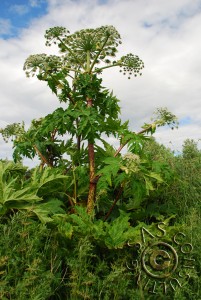Part of our work includes the surveying of invasive plant species. Giant hogweed Heracleum mantegazzianum is one such invasive. It is a particularly spectacular plant at this time of year as it will have formed a large central stalk (often over two metres tall) with a large umbrella-shaped head (umbel) of small white (rarely pinkish) flowers. Its sharply divided leaves can be up to three metres long and have bristles to their undersides. The stems are pale green with blotches of purple speckles these rarely coalesce to form solid purple areas.
It was the plant’s spectacular size and form that enticed plant collectors to introduce it to estates and gardens in Great Britain in the early 19th century. Such introductions continued for much of the 19th century and it was not long before outbreaks of the plant were being recorded in the wild.
Giant hogweed plants can live for several years but die once seeds have been borne. They persist in a rosette stage and usually flower in the third to fifth year. When conditions are unfavourable, such as on nutrient poor, shaded or dry sites or when regularly grazed, flowering is postponed until sufficient reserves have been accumulated. Each plant is capable of producing up to 100,000 seeds. These seeds can remain viable in the soil for up to 18 years. The seeds spread readily along watercourses and dense stands of giant hogweed form on riverbanks quickly shading out native vegetation. Denuded of other plant species, these riverbanks become highly susceptible to erosion when the hogweed plants die off in winter.
Anyone operating in areas infested with giant hogweed must be made aware of the health risks associated with the plant. It is necessary to avoid touching the plant with the bare skin and to prevent ultraviolet light from reaching skin that has been exposed. Toxicity may result from activities that involve bruising, cutting or touching the plant. All body parts must be covered with protective clothing. Cotton and linen fabrics should be avoided since their fibres soak up the plant sap and they can also be penetrated by plant hairs. Synthetic water-resistant materials offer far greater protection. Gloves with long sleeves should be worn and, if cutting this plant, protective goggles or glasses must be used to prevent drops of plant sap entering the eyes.
Care should be taken not to scratch or otherwise touch exposed skin with gloves covered in sap. Modern power equipment such as trimmers or weed whackers can spray pulverized plant material; therefore, it is essential to wear additional safety goggles or glasses including protection from inhalation.
In the event of skin exposure to the plant sap, the affected area should be wash carefully with soap and water as soon as possible and subsequently kept away from sunlight for at least 48 hours. Treatment with topical steroids early in the reaction can reduce the severity and ease discomfort. In the following months, a sun-cream should be used for the sensitive areas. If sap goes into the eyes, rinse them with water and use sunglasses. Seek medical advice as soon as possible, particularly after intensive contact.
The ultimate aim of long term control of giant hogweed must be its total eradication. When dealing with outbreaks along watercourses the control strategy ought to start with an extensive survey of the watercourse to map the locations of plants. Only then can a management plan be drawn up that will effectively deal with the problem.


